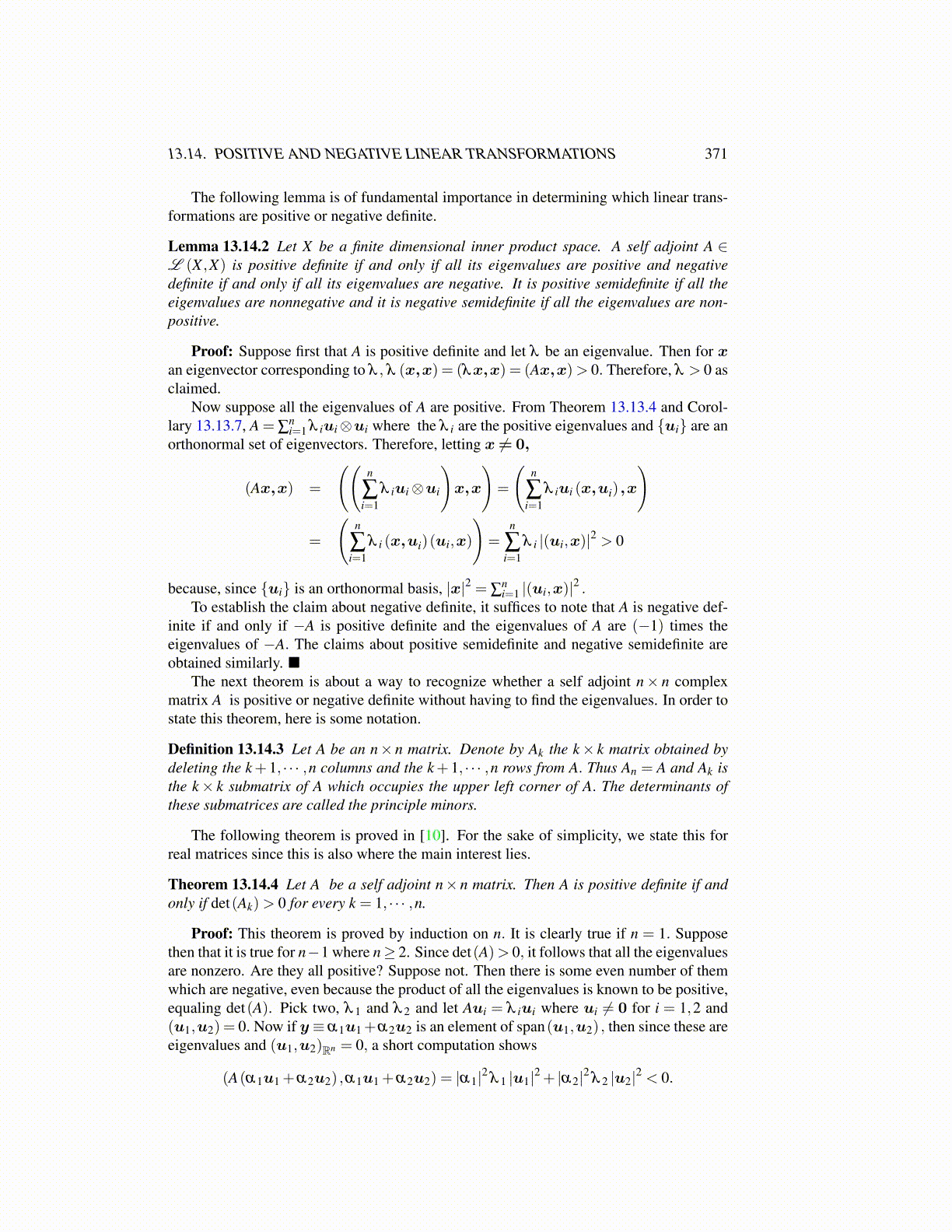
13.14. POSITIVE AND NEGATIVE LINEAR TRANSFORMATIONS 371
The following lemma is of fundamental importance in determining which linear trans-formations are positive or negative definite.
Lemma 13.14.2 Let X be a finite dimensional inner product space. A self adjoint A ∈L (X ,X) is positive definite if and only if all its eigenvalues are positive and negativedefinite if and only if all its eigenvalues are negative. It is positive semidefinite if all theeigenvalues are nonnegative and it is negative semidefinite if all the eigenvalues are non-positive.
Proof: Suppose first that A is positive definite and let λ be an eigenvalue. Then for xan eigenvector corresponding to λ , λ (x,x) = (λx,x) = (Ax,x)> 0. Therefore, λ > 0 asclaimed.
Now suppose all the eigenvalues of A are positive. From Theorem 13.13.4 and Corol-lary 13.13.7, A = ∑
ni=1 λ iui⊗ui where the λ i are the positive eigenvalues and {ui} are an
orthonormal set of eigenvectors. Therefore, letting x ̸= 0,
(Ax,x) =
((n
∑i=1
λ iui⊗ui
)x,x
)=
(n
∑i=1
λ iui (x,ui) ,x
)
=
(n
∑i=1
λ i (x,ui)(ui,x)
)=
n
∑i=1
λ i |(ui,x)|2 > 0
because, since {ui} is an orthonormal basis, |x|2 = ∑ni=1 |(ui,x)|2 .
To establish the claim about negative definite, it suffices to note that A is negative def-inite if and only if −A is positive definite and the eigenvalues of A are (−1) times theeigenvalues of −A. The claims about positive semidefinite and negative semidefinite areobtained similarly. ■
The next theorem is about a way to recognize whether a self adjoint n× n complexmatrix A is positive or negative definite without having to find the eigenvalues. In order tostate this theorem, here is some notation.
Definition 13.14.3 Let A be an n× n matrix. Denote by Ak the k× k matrix obtained bydeleting the k+1, · · · ,n columns and the k+1, · · · ,n rows from A. Thus An = A and Ak isthe k× k submatrix of A which occupies the upper left corner of A. The determinants ofthese submatrices are called the principle minors.
The following theorem is proved in [10]. For the sake of simplicity, we state this forreal matrices since this is also where the main interest lies.
Theorem 13.14.4 Let A be a self adjoint n× n matrix. Then A is positive definite if andonly if det(Ak)> 0 for every k = 1, · · · ,n.
Proof: This theorem is proved by induction on n. It is clearly true if n = 1. Supposethen that it is true for n−1 where n≥ 2. Since det(A)> 0, it follows that all the eigenvaluesare nonzero. Are they all positive? Suppose not. Then there is some even number of themwhich are negative, even because the product of all the eigenvalues is known to be positive,equaling det(A). Pick two, λ 1 and λ 2 and let Aui = λ iui where ui ̸= 0 for i = 1,2 and(u1,u2) = 0. Now if y≡ α1u1+α2u2 is an element of span(u1,u2) , then since these areeigenvalues and (u1,u2)Rn = 0, a short computation shows
(A(α1u1 +α2u2) ,α1u1 +α2u2) = |α1|2 λ 1 |u1|2 + |α2|2 λ 2 |u2|2 < 0.